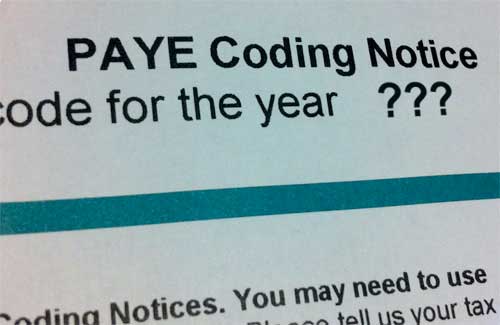The PAYE Coding Notice
Before the start of each tax year you are sent a Tax Coding Notice from HMRC, which provides your employer or pension company how much tax to deduct from what they pay you. HMRC used to send the notice to your accountant or tax adviser too, but no longer do this - so make sure any agent acting on your behalf knows what your tax code is.
The Coding Notice includes two sections, one for positive amounts, which are added up to provide you with a personal tax free allowance. The other section is for negative amounts, these are added up and deducted from the calculated personal tax free allowance.
Positive amounts, which are generally amounts you are allowed to earn/receive without paying tax on them, and can include:
- Tax-free allowances
- Personal Allowance and Blind Person's Allowance.
- Other allowances
- Married couple's allowance, work-related expenses such as professional subscriptions.
Negative amounts, which are amounts you have earned/received already without having tax deducted, and can include:
- Benefits In Kind
- Medical Insurance, Company Car, Other taxable perks
- Collection of Unpaid Taxes
- Adjustments to tax paid for example underpayments, self assessment under £3,000 can be collected through the tax code.
If subtracting your positive from negative results in a positive number, you still have a regular tax code, albeit reduced from the basic allowed for your age/date of birth.
If however, the resultant figure is a negative number, it means your tax code becomes a 'K' code. This means you personal tax free allowance becomes negative and is actually added to the total amount you can be taxed on.
For example, a tax code such as K250 would be equivalent to a tax free allowance of minus £2,500. So if you earned £10,000, you would actually be taxed on £12,500.
Tax Code Check
You can use our calculators in two ways to check if you are on the correct tax code:
- For single incomes, use our tax calculator here and enter your tax code along with your income details and date of birth/sex. We will check the tax deducted against what the standard tax code for your circumstances should be - if their is an overpayment of tax, this will be detailed for you.
- If you have two income sources, use our tax compare calculator here. Enter your incomes and personal details. The calculator will firstly check the amount of tax paid separately before combining the income into a single income with your basic tax free allowance. If an overpayment is detected, it will be detailed for you.
Decoding Tax Codes
In most cases, the numbers before or after the letter are multiplied by ten to provide a figure used as the tax free allowance. If the first letter is a K, this means the figure generated should be a negative amount.
To find out more about about what each of the letters at the end or beginning of a tax code mean, view our section on tax codes in how we calculate tax.

